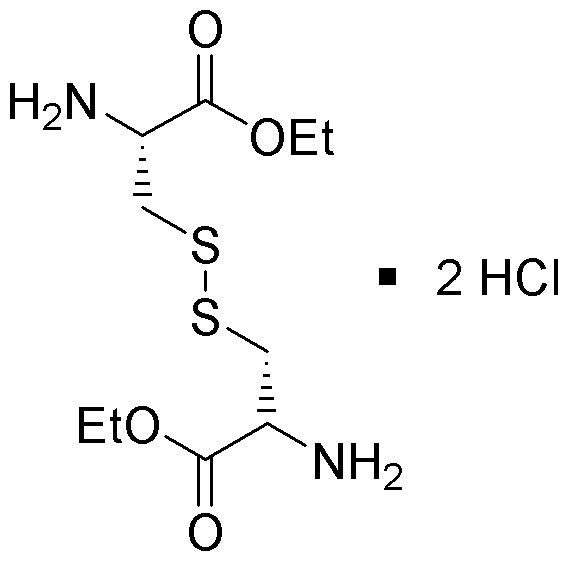L-Cystine bis-ethyl ester dihydrochloride is widely utilized in research focused on:
- Pharmaceutical Development: This compound serves as a precursor in synthesizing various pharmaceuticals, particularly those targeting oxidative stress and neurodegenerative diseases, enhancing drug efficacy.
- Antioxidant Formulations: Its antioxidant properties make it valuable in cosmetic products, helping to protect skin from damage caused by free radicals and promoting overall skin health.
- Biochemical Research: Researchers use it to study protein interactions and cellular processes, providing insights into metabolic pathways and potential therapeutic targets.
- Nutritional Supplements: It is incorporated into dietary supplements aimed at improving cysteine levels in the body, which can support immune function and detoxification processes.
- Food Industry: The compound can be used as a food additive to enhance the nutritional profile of products, particularly in formulations designed for health-conscious consumers.
General Information
Properties
Safety and Regulations
Applications
L-Cystine bis-ethyl ester dihydrochloride is widely utilized in research focused on:
- Pharmaceutical Development: This compound serves as a precursor in synthesizing various pharmaceuticals, particularly those targeting oxidative stress and neurodegenerative diseases, enhancing drug efficacy.
- Antioxidant Formulations: Its antioxidant properties make it valuable in cosmetic products, helping to protect skin from damage caused by free radicals and promoting overall skin health.
- Biochemical Research: Researchers use it to study protein interactions and cellular processes, providing insights into metabolic pathways and potential therapeutic targets.
- Nutritional Supplements: It is incorporated into dietary supplements aimed at improving cysteine levels in the body, which can support immune function and detoxification processes.
- Food Industry: The compound can be used as a food additive to enhance the nutritional profile of products, particularly in formulations designed for health-conscious consumers.
Documents
Safety Data Sheets (SDS)
The SDS provides comprehensive safety information on handling, storage, and disposal of the product.
Product Specification (PS)
The PS provides a comprehensive breakdown of the product’s properties, including chemical composition, physical state, purity, and storage requirements. It also details acceptable quality ranges and the product's intended applications.
Certificates of Analysis (COA)
Search for Certificates of Analysis (COA) by entering the products Lot Number. Lot and Batch Numbers can be found on a product’s label following the words ‘Lot’ or ‘Batch’.
*Catalog Number
*Lot Number
Certificates Of Origin (COO)
This COO confirms the country where the product was manufactured, and also details the materials and components used in it and whether it is derived from natural, synthetic, or other specific sources. This certificate may be required for customs, trade, and regulatory compliance.
*Catalog Number
*Lot Number
Safety Data Sheets (SDS)
The SDS provides comprehensive safety information on handling, storage, and disposal of the product.
DownloadProduct Specification (PS)
The PS provides a comprehensive breakdown of the product’s properties, including chemical composition, physical state, purity, and storage requirements. It also details acceptable quality ranges and the product's intended applications.
DownloadCertificates of Analysis (COA)
Search for Certificates of Analysis (COA) by entering the products Lot Number. Lot and Batch Numbers can be found on a product’s label following the words ‘Lot’ or ‘Batch’.
*Catalog Number
*Lot Number
Certificates Of Origin (COO)
This COO confirms the country where the product was manufactured, and also details the materials and components used in it and whether it is derived from natural, synthetic, or other specific sources. This certificate may be required for customs, trade, and regulatory compliance.


